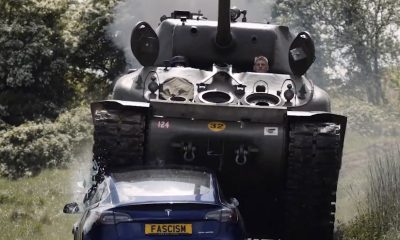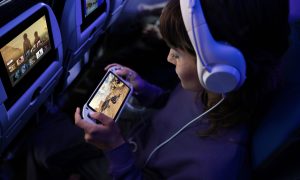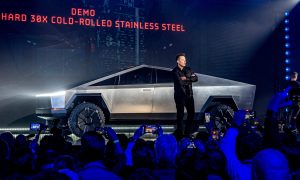

News
Tesla’s rise in South Korea pushes Hyundai to focus on EVs instead of hydrogen
In a 2014 book, Hyundai’s then R&D Chief Lee Hyun-soon, who also happens to be the one who developed South Korea’s first gasoline engines, argued that electric vehicles were “not realistic,” and part of this is due to their high battery costs. According to Lee, hydrogen based cars are a better zero emissions alternative, and the technology offered a “bright future.”
Hyundai, together with experienced carmakers such as Toyota and upstart companies like Nikola, bet big on the adoption and spread of hydrogen vehicles. The company launched the Tucson Fuel Cell in 2013 and the NEXO in 2018, both of which garnered a fair amount of optimism. However, this optimism did not translate to sales, and the hydrogen boom that was to come did not come at all.
Last year, 7,707 hydrogen fuel cell cars were sold globally. In comparison, there were 1.68 million electric vehicles that were sold in 2019, more than 86,000 of which came from Hyundai itself, as per figures from LMC Automotive. Tesla, the leader in EVs today, sold a whopping 367,500 vehicles last year, and that’s with a lineup comprised solely of premium cars.
Tesla’s expansion has been felt in South Korea. Since the launch of the Model 3, Tesla has spread its reach into the country. In June alone, Tesla had its best month in South Korea, beating Hyundai’s Kona EV and other premium rivals from BMW and Audi. Last month, South Korea’s rental service firm SK Rent-a-Car even announced that it would be adding the Tesla Model 3 to its fleet, simply because new Tesla products were the “most favored” electric cars among its customers.
In a statement to Reuters, an industry insider stated that Tesla’s rise has caught Hyundai by surprise. “Hyundai did not expect Tesla to dominate the EV market so quickly,” the source said. But with the demand for electric cars being established and highlighted in the country by Tesla’s rise, Hyundai is mobilizing to catch up. An internal union newsletter retrieved by the news outlet, for example, revealed that Hyundai intends to introduce two production lines dedicated to EVs in the near future. The first of these would be introduced as early as next year.
Euisun Chung, the leader of the Hyundai Motor Group conglomerate, has reportedly held a series of meetings with his counterparts at Samsung, LG, and SK Group, companies that manufacture batteries and electronic parts. In a statement to Reuters, Hyundai noted that it was collaborating with South Korean battery suppliers to “scale up” its EV production capabilities to compete in the electric car segment better.
Amidst these strategies, Hyundai has started what appears to be a definitive step away from hydrogen cars to electric vehicles. The company still promotes its hydrogen cars with popular K-pop band BTS, but it only intends to produce two hydrogen vehicles by 2025. In comparison, the company intends to have 23 battery powered cars by then. This was highlighted in a statement last month by Chung, who stated that the company wants to sell 1 million EVs per year, grabbing a global market share of 10%, by 2025.
News
Starship Flight 9 nears as SpaceX’s Starbase becomes a Texan City
SpaceX’s launch site is officially incorporated as Starbase, TX. Starship Flight 9 could launch on May 27, 2025.

SpaceX’s Starbase is officially incorporated as a city in Texas, aligning with preparations for Starship Flight 9. The newly formed city in Cameron County serves as the heart of SpaceX’s Starship program.
Starbase City spans 1.5 square miles, encompassing SpaceX’s launch facility and company-owned land. A near-unanimous vote by residents, who were mostly SpaceX employees, led to its incorporation. SpaceX’s Vice President of Test and Launch, Bobby Peden, was elected mayor of Starbase. The new Texas city also has two SpaceX employees as commissioners. All Starbase officials will serve two-year terms unless extended to four by voters.
As the new city takes shape, SpaceX is preparing for the Starship Flight 9 launch, which is tentatively scheduled for May 27, 2025, at 6:30 PM CDT from Starbase, Texas.
SpaceX secured Federal Aviation Administration (FAA) approval for up to 25 annual Starship and Super Heavy launches from the site. However, the FAA emphasized that “there are other licensing requirements still to be completed,” including policy, safety, and environmental reviews.
On May 15, the FAA noted SpaceX updated its launch license for Flight 9, but added: “SpaceX may not launch until the FAA either closes the Starship Flight 8 mishap investigation or makes a return to flight determination. The FAA is reviewing the mishap report SpaceX submitted on May 14.”
Proposed Texas legislation could empower Starbase officials to close local highways and restrict Boca Chica Beach access during launches. Cameron County Judge Eddie Trevino, Jr., opposes the Texas legislation, insisting beach access remain under county control. This tension highlights the balance between SpaceX’s ambitions and local interests.
Starbase’s incorporation strengthens SpaceX’s operational base as it gears up for Starship Flight 9, a critical step in its mission to revolutionize space travel. With growing infrastructure and regulatory hurdles in focus, Starbase is poised to become a cornerstone of SpaceX’s vision, blending community development with cutting-edge aerospace innovation.
News
The Boring Company accelerates Vegas Loop expansion plans
The Boring Company clears fire safety delays, paving the way to accelerating its Vegas Loop expansion plans.

After overcoming fire safety hurdles, the Boring Company is accelerating its Vegas Loop expansion. The project’s progress signals a transformative boost for Sin City’s transportation and tourism.
Elon Musk’s tunneling company, along with The Las Vegas Convention and Visitors Authority (LVCVA) and Clark County, resolved fire safety concerns that delayed new stations.
“It’s new. It’s taken a little time to figure out what the standard should be,” said Steve Hill, LVCVA President and CEO, during last week’s board meeting. “We’ve gotten there. We’re excited about that. We’re ready to expand further, faster, than we have.”
Last month, the company submitted permits for tunnel extensions connecting Encore to a parcel of land owned by Wynn and Caesars Palace. The three tunnels are valued at $600,000 based on country records.
Plans for a Tropicana Loop are also advancing, linking UNLV to MGM Grand, T-Mobile Arena, Allegiant Stadium, Mandalay Bay, and the upcoming Athletics’ ballpark. Downtown extensions from the convention center to the Strat, Fremont Street Experience, and Circa’s Garage Mahal are also in the permitting process.
“Those are all in process,” Hill noted. “We’ve got machines that are available to be put in the ground. I think we’ve reached a framework for how these projects are going to work and how they’ll be permitted from a safety standpoint, as well as a building standpoint.”
The Boring Company has six boring machines, with three currently active in Las Vegas. Last week, TBC announced that it successfully mined continuously in a Zero-People-in-Tunnel (ZPIT) configuration, enabling it to build more tunnels faster, safer, and at a more affordable rate.
Tunneling under Paradise Road is underway as The Boring Company works on the University Center Loop. The University Center Loop is expected to connect to the Las Vegas Convention Center within two months, linking to the Westgate tunnel. The full Vegas Loop will span 104 stations and 68 miles. Even though The Boring Company’s tunnel network in Las Vegas isn’t nearly finished, it has already become a key attraction in the city.
“It’s such a great attraction for shows that are looking at this building (convention center) and we’re going to be connected to everybody in town,” Hill said. “It’s a real difference-maker.”
A few Vegas Loop stations are already operational, including those connected to Resorts World, Westgate, Encore, and all the Las Vegas Convention Center Loop stations. The Downtown Loop, which connects to the downtown area, and the Riviera Station, the hub that leads to Resorts World with Westgate destinations, are also operational.
As The Boring Company accelerates the Vegas Loop, its tunnels are poised to redefine mobility and tourism in Las Vegas, blending cutting-edge technology with practical urban solutions.
News
Neuralink Blindsight human trials expected to start in the UAE
Neuralink aims to restore vision with its Blindsight BCI implant. First human implant for Blindsight may happen in UAE.

During Elon Musk’s interview at the Qatar Economic Forum, he announced that Neuralink aims to implant its Blindsight brain-to-computer interface (BCI) device in a human patient by late 2025 or early 2026.
Blindsight focuses on restoring vision. A few years ago, Musk mentioned that Neuralink’s BCI devices would restore vision for people, even those born blind.
“The first two applications we’re going to aim for in humans are restoring vision, and I think this is notable in that even if someone has never had vision ever, like they were born blind, we believe we can still restore vision. The visual part of the cortex is still there. Even if they’ve never seen before, we’re confident they could see,” Musk said during Neuralink’s Show & Tell in 2022.
Musk said Blindsight could be implanted into a human patient in the United Arab Emirates (UAE). Neuralink plans to partner with the Cleveland Clinic Abu Dhabi to implant the first human patient with Blindsight.
Elon Musk’s neurotechnology company is partnering with the Cleveland Clinic Abu Dhabi to conduct the first clinical trial of the UAE-PRIME study. Like Neuralink’s PRIME study in the United States, UAE-PRIME will focus on human patients with motor and speech impairments.
Neuralink received Food and Drug Administration (FDA) approval to conduct the PRIME and CONVOY studies in the United States. PRIME tests the capabilities of the company’s Link implant to restore or enable motor and speech in participants. Meanwhile, the CONVOY study explores Link’s ability to control assistive robotic devices. Neuralink already has an assistive robotic arm called ARA that could expand patients’ autonomy beyond smart devices.
Blindsight would probably require a separate study from PRIME and CONVOY. As such, Neuralink might need FDA approval in the United States to start human trials for Blindsight. However, Blindsight already received a “breakthrough device” designation from the US FDA.
In April 2025, Neuralink opened its patient registry to participants worldwide. The neurotechnology company has already implanted its Link BCI device into five patients. Earlier this year, Neuralink welcomed one of its first PRIME study participants as the first patient in its CONVOY study.
-

 News2 weeks ago
News2 weeks agoTesla Cybertruck Range Extender gets canceled
-

 Elon Musk6 days ago
Elon Musk6 days agoTesla seems to have fixed one of Full Self-Driving’s most annoying features
-

 Lifestyle2 weeks ago
Lifestyle2 weeks agoAnti-Elon Musk group crushes Tesla Model 3 with Sherman tank–with unexpected results
-

 News2 weeks ago
News2 weeks agoStarlink to launch on United Airlines planes by May 15
-

 News2 weeks ago
News2 weeks agoTesla Semi gets new adoptee in latest sighting
-

 News2 weeks ago
News2 weeks agoTesla launches its most inexpensive trim of new Model Y
-

 News2 weeks ago
News2 weeks agoUS’ base Tesla Model Y has an edge vs Shanghai and Berlin’s entry-level Model Ys
-

 News2 weeks ago
News2 weeks agoTesla Cybertruck owners get amazing year-long freebie





















